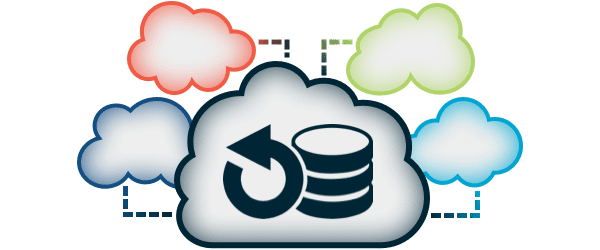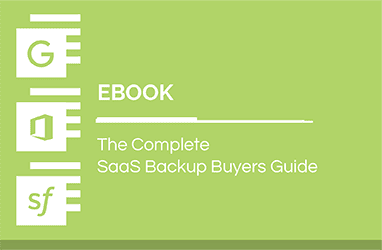What Is Cloud-To-Cloud Backup? How It Works and When to Use It
In today’s digital world, where businesses are expected to deliver services 24/7/365, data loss and subsequent downtime can be a death knell for them. Organizations must protect their critical data and always keep it readily available to continue business as usual in the case of adverse events. However, given the sprawl of data across hybrid and multicloud environments amidst an ever-increasing cyberthreat landscape, it isn’t an easy task.
Most organizations leverage multiple public and private clouds today to effectively deploy applications, avoid vendor lock-in and take advantage of best-of-breed solutions. However, this results in a fragmented data footprint across hybrid and multicloud infrastructures and a fractured ability to manage and secure data. According to Statista, 60% of all organizational data is now stored in the cloud, and the highest increase in cyberattacks is expected to occur on these cloud services and the data stored in the cloud. While also considering the shared responsibility model (SRM) of cloud security, which holds the customers responsible for protecting the data and workloads in the cloud tenant(s), it becomes imperative for organizations to secure their data in the cloud.
This is where cloud-to-cloud (C2C) backup can help organizations. Cloud-to-cloud backup solutions are purpose-built for backing up cloud data to an alternative cloud location to alleviate the challenges often associated with protecting data in the cloud. Let’s see what cloud-to-cloud backup is and how it can address your cloud data protection woes.
What is cloud-to-cloud backup?
According to TechTarget, cloud-to-cloud backup “is the practice of copying data stored on one cloud service to another cloud service. The backup stored on the second cloud service serves the same purpose as an off-site data backup.” With cloud-to-cloud backup, organizations can address a wide range of data threats, like accidental data deletion, data retention policy gaps, single-cloud risks, malware, ransomware and insider threats.
What data is protected with cloud-to-cloud backup?
Cloud-to-cloud backup is commonly used for SaaS applications like Google Workspace, Microsoft 365 and Salesforce. Backing up the SaaS data in an alternative cloud location primarily protects businesses from data loss incidents that impact the provider’s cloud.
Why is cloud-to-cloud backup needed?
SaaS applications have become indispensable for modern businesses, offering unprecedented agility, cost-effectiveness and scalability. According to Better Cloud, 85% of software used by organizations will be SaaS by 2025. However, this increasing prominence of SaaS applications makes them a lucrative target for cybercriminals. The bad guys can easily target your data stored in SaaS applications through end-user phishing, ransomware, malware and other malicious ways. As the volume of data stored in SaaS applications rises, so does the threat of cyber-risks.
However, thanks to the SRM of cloud security, the onus is on you to protect the data and workloads in the cloud tenant(s). According to the SRM, while the SaaS provider is responsible for protecting the infrastructure and networks, the customers should be responsible for identity and access management (IAM), encryption and protection of the data generated.
Leveraging a cloud-to-cloud backup will help you efficiently protect your SaaS data from many common cloud data threats, including accidental deletion of a file or folder. For example, if one of your employees accidentally deletes a file or folder from your cloud backup, you will not be able to get it back. However, a cloud-to-cloud backup gives you an extra layer of protection against such accidental deletion or data loss.
Cloud-to-cloud backups also eliminate single-cloud vulnerabilities. For instance, if your data backups remain in the same public cloud as your production workloads, you will face extensive business downtime in the event of the cloud’s outage. However, storing your data backup in a redundant cloud empowers you to spin up recovery infrastructure swiftly in the secondary cloud when the primary cloud faces an outage, helping you meet aggressive recovery time objectives (RTOs).

How does cloud-to-cloud backup work?
Cloud-to-cloud backups create a copy of your data and store it in a secondary cloud location. The cloud-to-cloud backup provider typically manages both the backup software and its implementation for the customers. The backups can be run automatically, and their frequency can be customized to meet unique needs. For example, you can create daily backups for your critical data and weekly backups for your less important data.
When an organization faces a data loss incident in their SaaS application, they can restore data from the target cloud and continue their business as usual. Some best-of-breed cloud-to-cloud backup solutions (like Spanning) also offer advanced search and granular restore capabilities, making data recovery seamless for users.
How is cloud-to-cloud different from traditional cloud backup?
Cloud backup, also called online backup or remote backup, is the process of copying the data and applications on a business’s server and storing it on a secondary, off-site server for safekeeping. Organizations can recover those data from the cloud in the event of a primary data failure. However, cloud-to-cloud backup is a more advanced cloud backup implementation. In cloud-to-cloud backup, data already within the cloud (like in SaaS applications) is copied and stored in a secondary cloud location. Similar to cloud backup, businesses can turn to secondary cloud storage and spin up their business-critical applications when there is an outage in the primary cloud.
Benefits of cloud-to-cloud backup
In today’s ever-evolving SaaS data threat landscape, cloud-to-cloud backups are essential to secure your SaaS data completely. It protects your SaaS data against many common and possible cases of data loss, like accidental deletion, insider threats and cyberattacks.
Cloud-to-cloud also helps in doing away with single-cloud vulnerabilities and resulting downtime. It helps keep your backups away from the production stack, thereby rendering them immune to any threats or outages that impact the production site. You can thus meet aggressive RTO requirements with cloud-to-cloud backup. These data backups are also accessible anytime, anywhere.
Limitations of cloud-to-cloud backup
Since cloud services are scalable, backup data sets can swiftly grow in the storage space, and organizations need to keep an eye out for the growing data volume. As the costs can escalate and management can get complex, it’s ideal to go with a vendor that offers easy and transparent license management. On that front, organizations can also look for advanced features, like license archiving, that can optimize backup costs.
Data backup and restoration can also get complex in SaaS applications. So, organizations have to look for solutions that have automated and end-user self-service capabilities to make the backup and recovery process seamless.
Backup SaaS data cloud-to-cloud with Spanning
Spanning makes your SaaS data backup and recovery automated and effortless with its purpose-built solutions. Spanning Backup for Microsoft 365, Google Workspace and Salesforce are plug-and-play backup and recovery solutions that automate your data backups and simplify your recovery processes so your team can do more with less. Spanning works closely with Microsoft, Google and Salesforce in that regard and has been honored as a Microsoft Silver Partner for Application Development and Google for Work Premier Partner.
Spanning Backup has automated daily and on-demand backups to cater to your unique backup needs. Its intuitive restore capabilities, like point-in-time restores, granular search and restore, and cross-user restore, make data recovery seamless. The solution also offers effortless license management and has the lowest total cost of ownership (TCO) in its class.
Take 15 minutes out of your time and get a demo of Spanning Backup to discover how affordable, simple and reliable it is. Start your journey to a simpler, smarter and better backup and recovery today.





